The Netherlands had to face a very tough Sweden in the semi-finals of the 2019 FIFA Women’s World Cup but they proved brave enough to overcome the difficult challenge.
Sarina Wiegman’s side brushed Italy aside with the scoreline of 2-0 to advance to the semi-finals, while Peter Gerhardsson took the two-time world champions Germany by surprise and shrugged them off in a thrilling 1-2 victory in Lorient.
Despite having to play until overtime, the Netherlands eventually managed to defeat relentless Sweden. Central midfielder Jackie Groenen scored the only goal for the Dutch side in the extra time.
In this tactical analysis, we will delve into how the Netherlands overcame Sweden to secure a place in the final.
Lineups
Netherlands (4-3-3)
Starting XI: van Veenendaal – van Lunteren, van der Gragt, Bloodworth, van Dongen – Spitse, Groenen, van de Donk – Beerensteyn, Miedema, Martens
Bench: van Es, Dekker, van de Sanden, Pelova, R. Jansen, Kaagman, E. Jansen, Kop, Kerkdijk, Roord, van der Most, Geurts
Coach: Sarina Wiegman
Sweden (4-2-3-1)
Starting XI: Lindahl – Glas, Fischer, Sembrant, Ericsson – Rubensson, Seger – Jakobsson, Asllani, Hurtig – Blackstenius
Bench: Andersson, Janogy, Falk, Ilestedt, Roddar, Zigiotti, Anvegard, Larsson, Musovic, Schough
Coach: Peter Gerhardsson
Netherlands’ setup – tactical analysis
Wiegman made only one change to her side in this match with Lineth Beerensteyn coming in to replace Shanice van de Sanden. The rest was just the same as the last game. Wiegman rarely rotated her squad and it was apparent by the fact that she has only used a total of 14 players so far in her squad in the 2019 FIFA Women’s World Cup.
Wiegman set up her team to play in their usual 4-3-3 system with the view of shifting into 2-3-5 in attack. In the second half, Wiegman seemed to change the formation of her team, shifting into a 4-2-3-1 shape with Jackie Groenen playing alongside Sherida Spitse as the double pivot. Danielle van de Donk played in the attacking midfield role behind striker Vivianne Miedema. Jill Roord replaced Lieke Martens in the second half and briefly played in the left-wing before swapping positions with van de Donk later in the second half.
Sweden’s setup
There was also only one change in the Sweden team with Lina Hurtig replacing Fridolina Rolfo in the starting line-up.
Gerhardsson, as usual, deployed his team in a 4-2-3-1 system. This was a bit different than their last setup against Germany in which they used a 4-4-2 system with Kosovare Asllani playing alongside Stina Blackstenius in the striker role.
In this game, they seemed to form a 4-4-2 shape in defence and looked more like a 2-4-4 in attack.
There seemed to be no change in their system throughout the game.
Build-up play made difficult
Sweden played smart in this game. They paid close attention to the Netherlands’ best passers, Bloodworth and Spitse. This made the Netherlands’ build-up play much, much more difficult than usual.
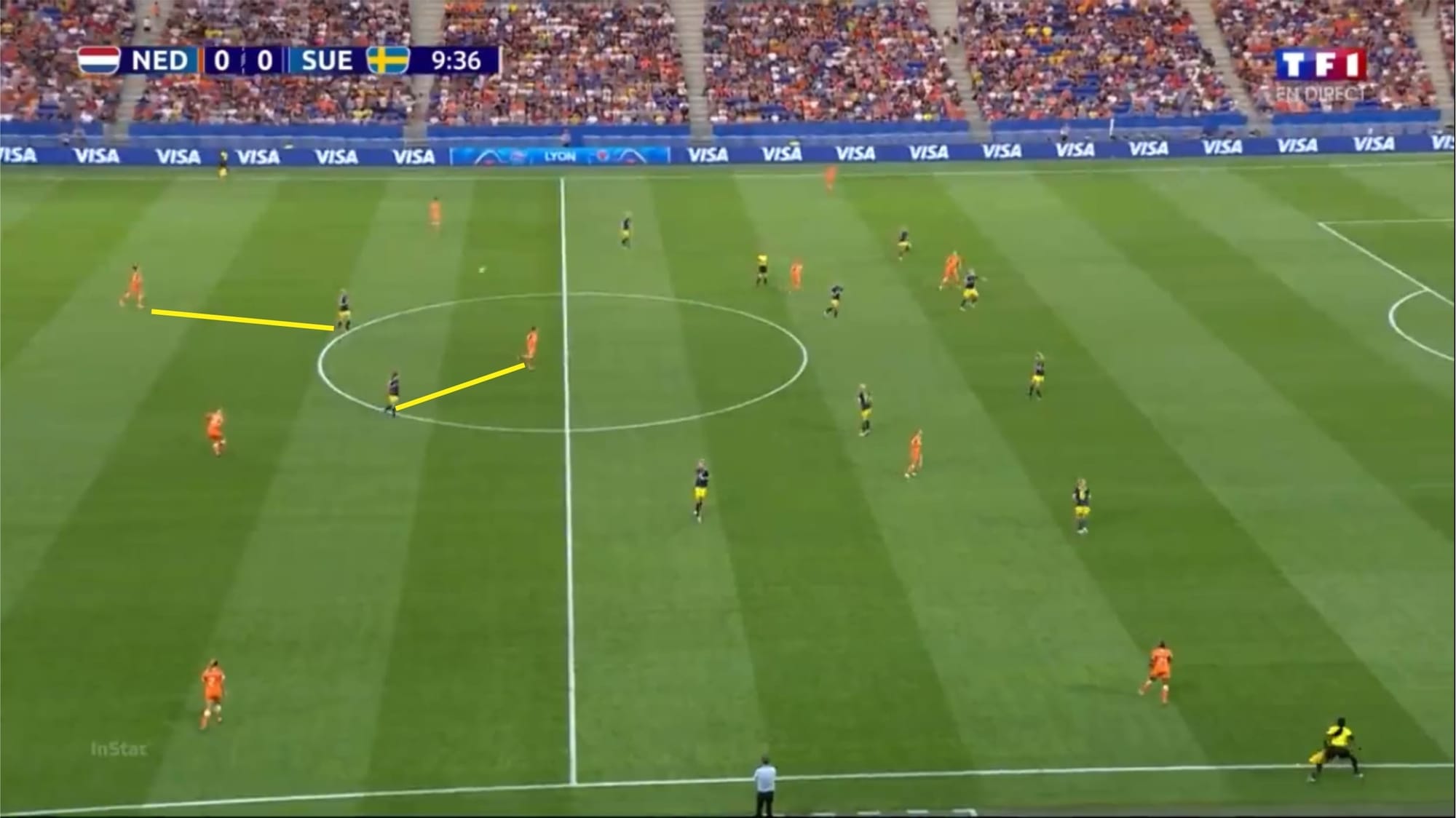
Using this picture alone, we can see a lot of tactical instructions being applied in play. I will explain more about that in this analysis.
The picture above, in particular, shows Netherlands centre-back Stefanie van der Gragt opting for a long diagonal pass towards Martens on the left side of the wing. Sweden’s attacking midfielder, Asllani also didn’t seem to close her down, but rather trying to mark the passing lane towards Spitse. If van der Gragt passed the ball to Bloodworth, Blackstenius would immediately close her down and press her. That way, Bloodworth would have no time at all to deliver a perfect progressive pass.
This strategy came into play all the way until the end of the game and I can safely say that this affected the Netherlands’ build-up massively.
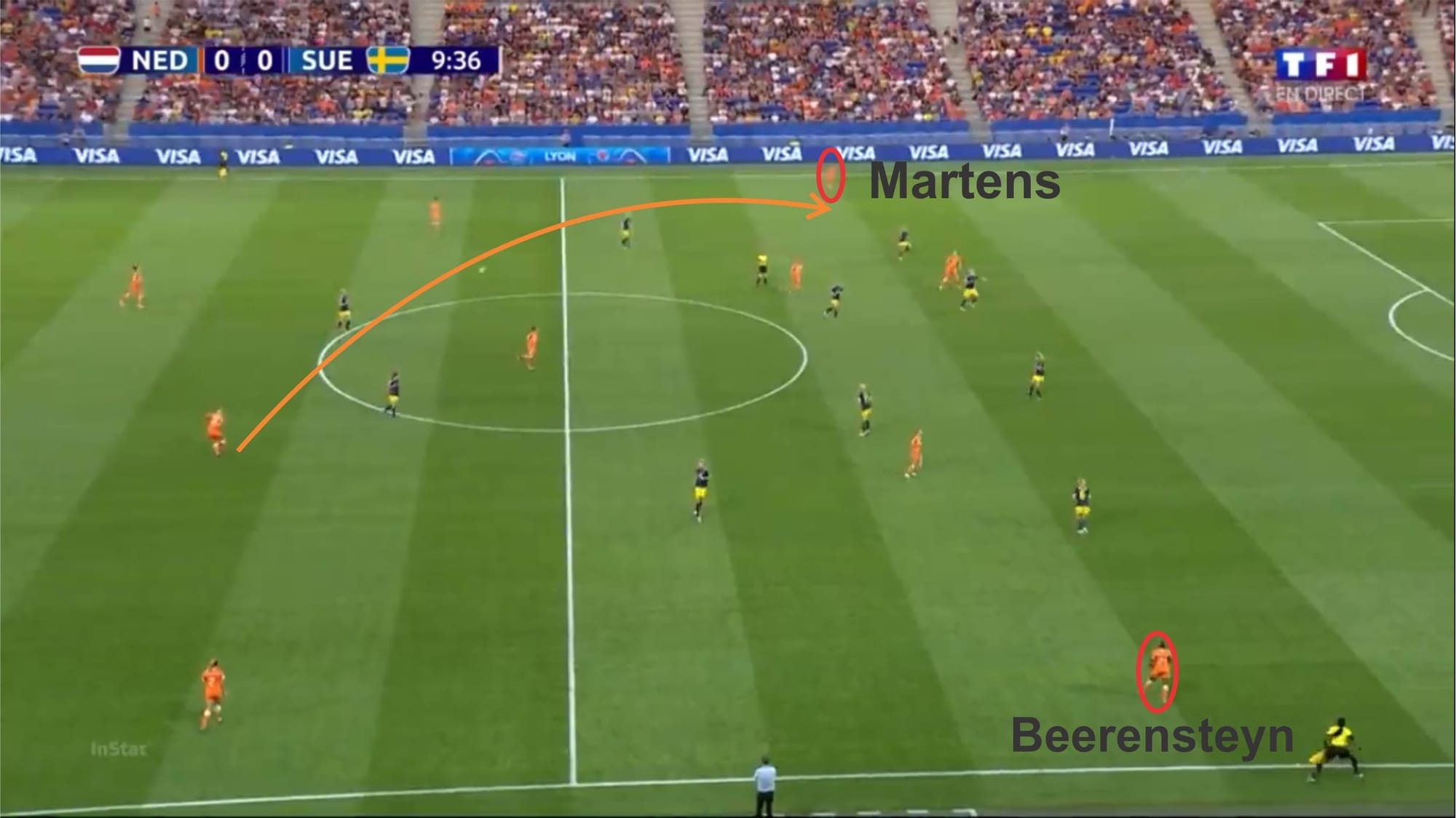
However, as usual, the Netherlands still tried to play long diagonal balls. We can see the two wingers stretching wide, trying to open up spaces out wide. Van der Gragt picked Martens on the far side. The latter was immediately met with pressure from Sweden – who tried to swarm and isolate her.
This didn’t seem to work well for the Netherlands most of the time, knowing that Sweden had a fairly wide defensive line. The away team also played with a compact mid-low block which allowed the Netherlands to play out rather freely at the back but denied them from exploiting spaces behind the defence.
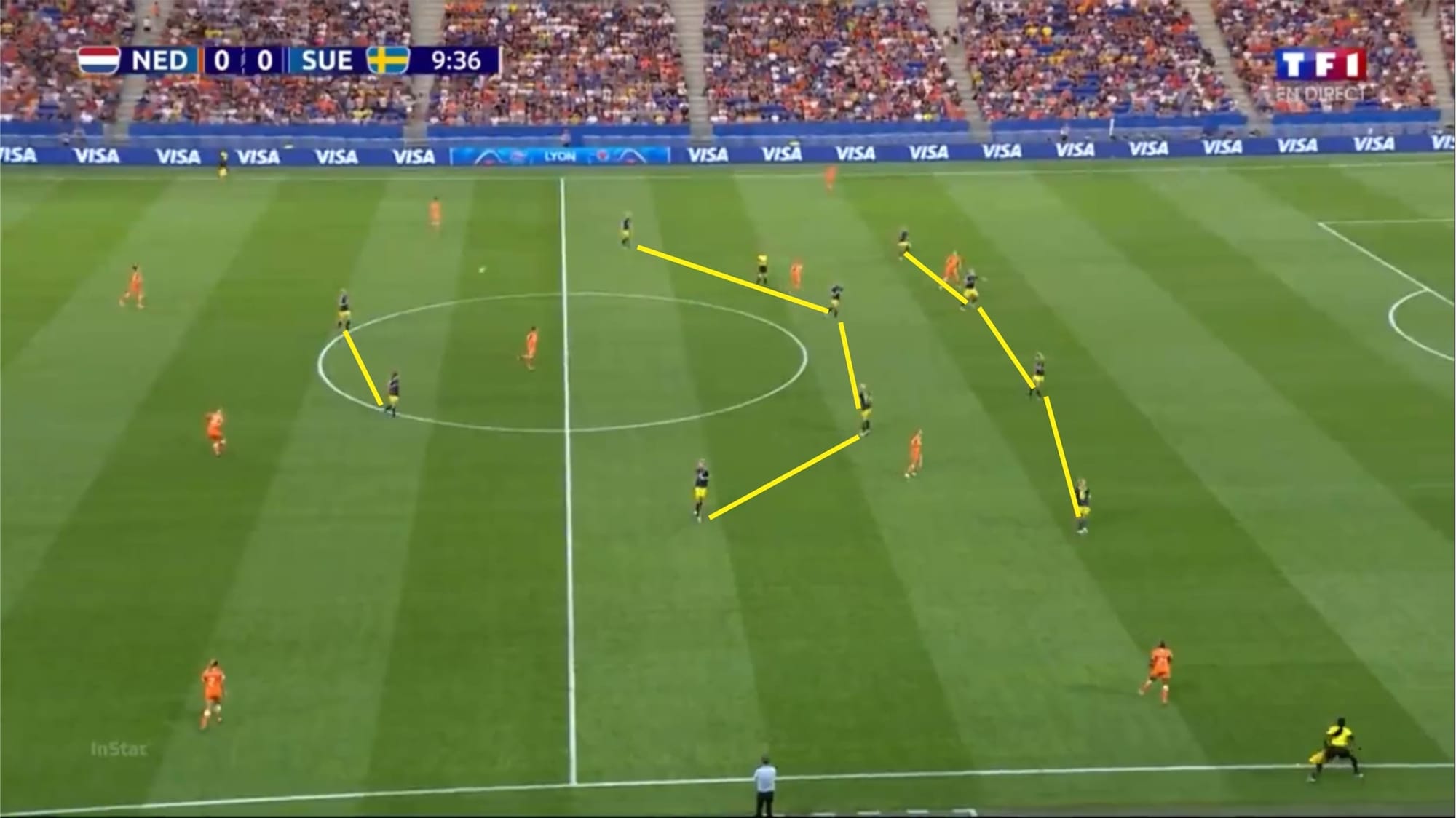
We can also see from the very same picture above that Sweden were defending with two banks of four in a 4-4-2 shape.
The wingers dropped deep and sit narrower, effectively crowding the middle. Asllani, meanwhile, would mark Spitse, while Blackstenius marked Bloodworth. The defensive line was not narrow, but not quite wide as well, just enough for them to attract the Netherlands into playing diagonal long passes which would activate their pressing trap out wide.
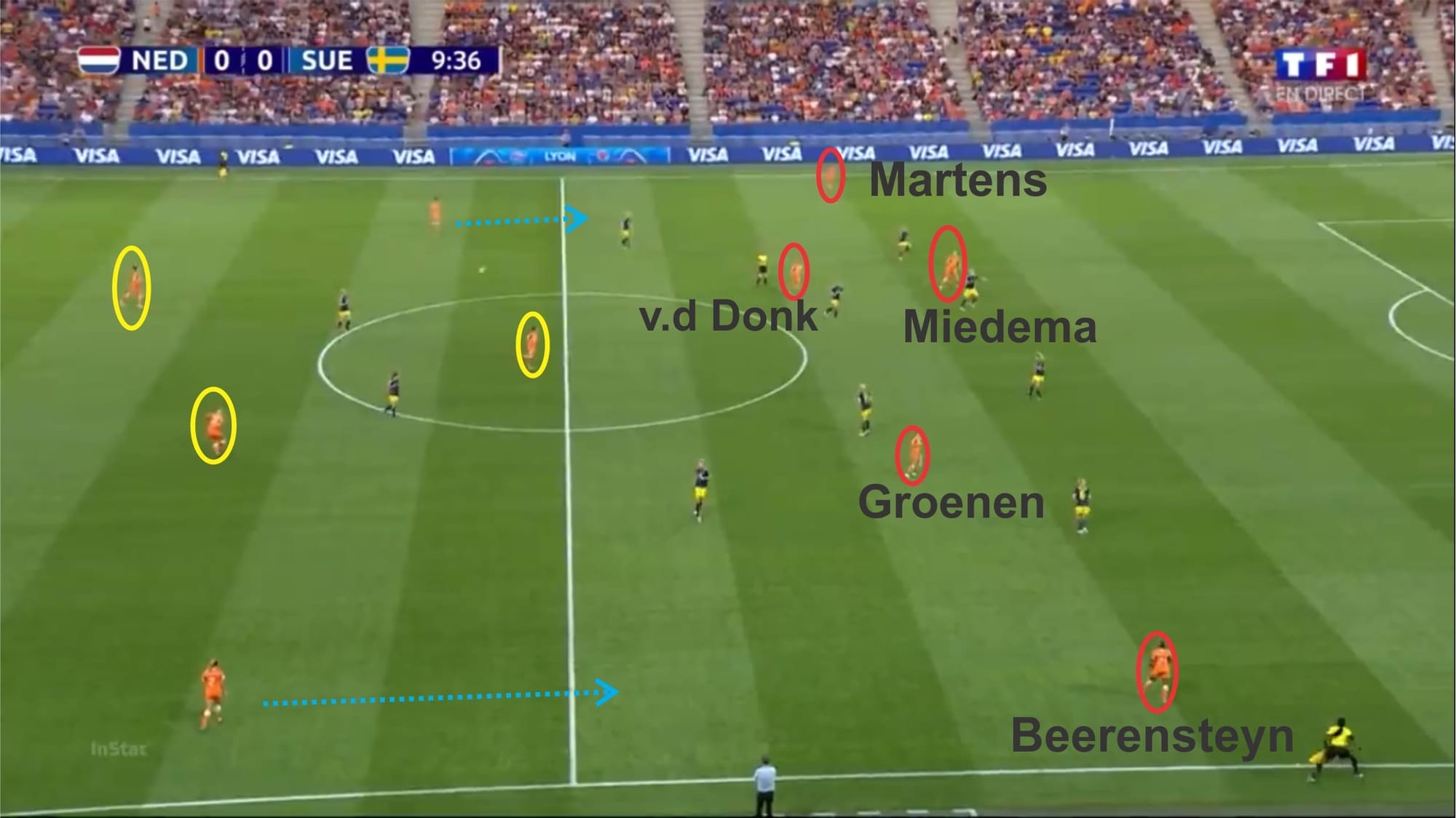
This picture also shows the Netherlands’ attacking shape. As usual, Wiegman instructed his team to throw a number of players forward, trying to outnumber the opposing defenders. They took on a 2-3-5 shape in attack. The two full-backs advanced forward just above the halfway line, near the wingers. Spitse held her position and stayed central. She very rarely participated in attacks as her role was predominantly to anticipate and destroy the opposition’s attempts to launch a counter.
This shape, however, seemed to change in the second half. With Wiegman tweaking the system, changing into a 4-2-3-1 with Groenen playing alongside Spitse as the double pivot and Roord/van de Donk playing in front of them, their attacking shape looked a bit like 2-4-4.
Still, the Netherlands were struggling to break Sweden’s solid defence. Now there’s actually a way that the Netherlands could do to create a breakthrough. Which I’d explain in this scenario.
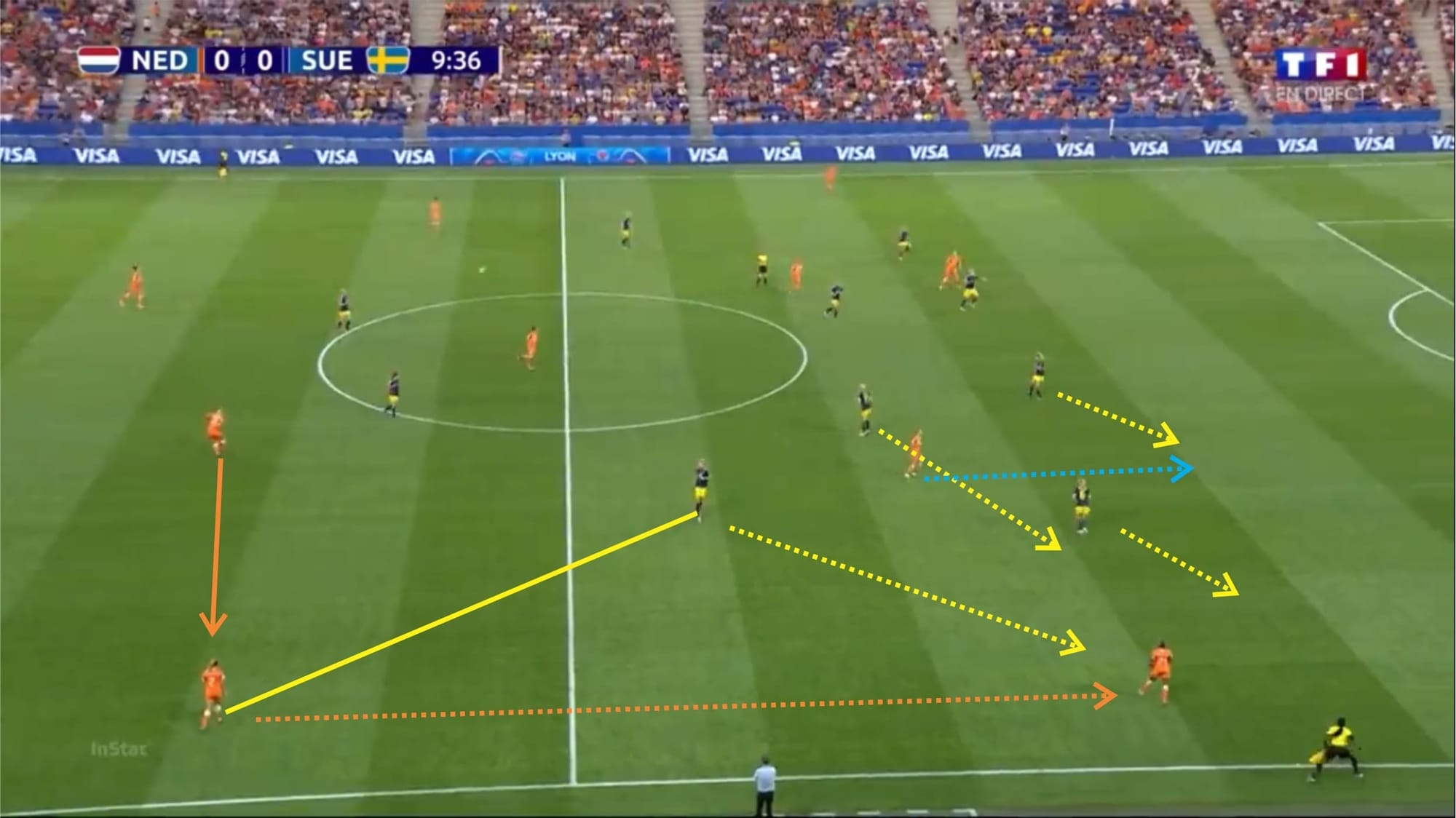
Now what really happened in this picture was van der Gragt passing it forward diagonally towards Martens. But there’s an alternative way to attack for the Netherlands.
If van der Gragt gave the ball to van Lunteren, Beerensteyn should drop deeper to attract the full-back out of position. That way, Groenen could have exploited the spaces out wide although still having to face Sweden’s centre-back who’d probably close her down and cover the space in her defence. If van Lunteren played the ball towards Beerensteyn without the latter dropping deep, Sweden would immediately activate their pressing trap, swarm her, and isolate her on the flank, making it difficult for her to get forward and possibly also winning the ball back.
With Sweden’s wingers dropping deep and sitting narrower to overload the middle, the full-backs were left with a lot of freedom to play the ball. Let’s also put in mind that Sweden’s defensive tactics were to form a compact mid-low block and only press when the ball was inside their own half.
If van der Gragt gave the ball to van Lunteren, the Netherlands would probably be able to trigger their usual attacking routine. As shown in this picture below.
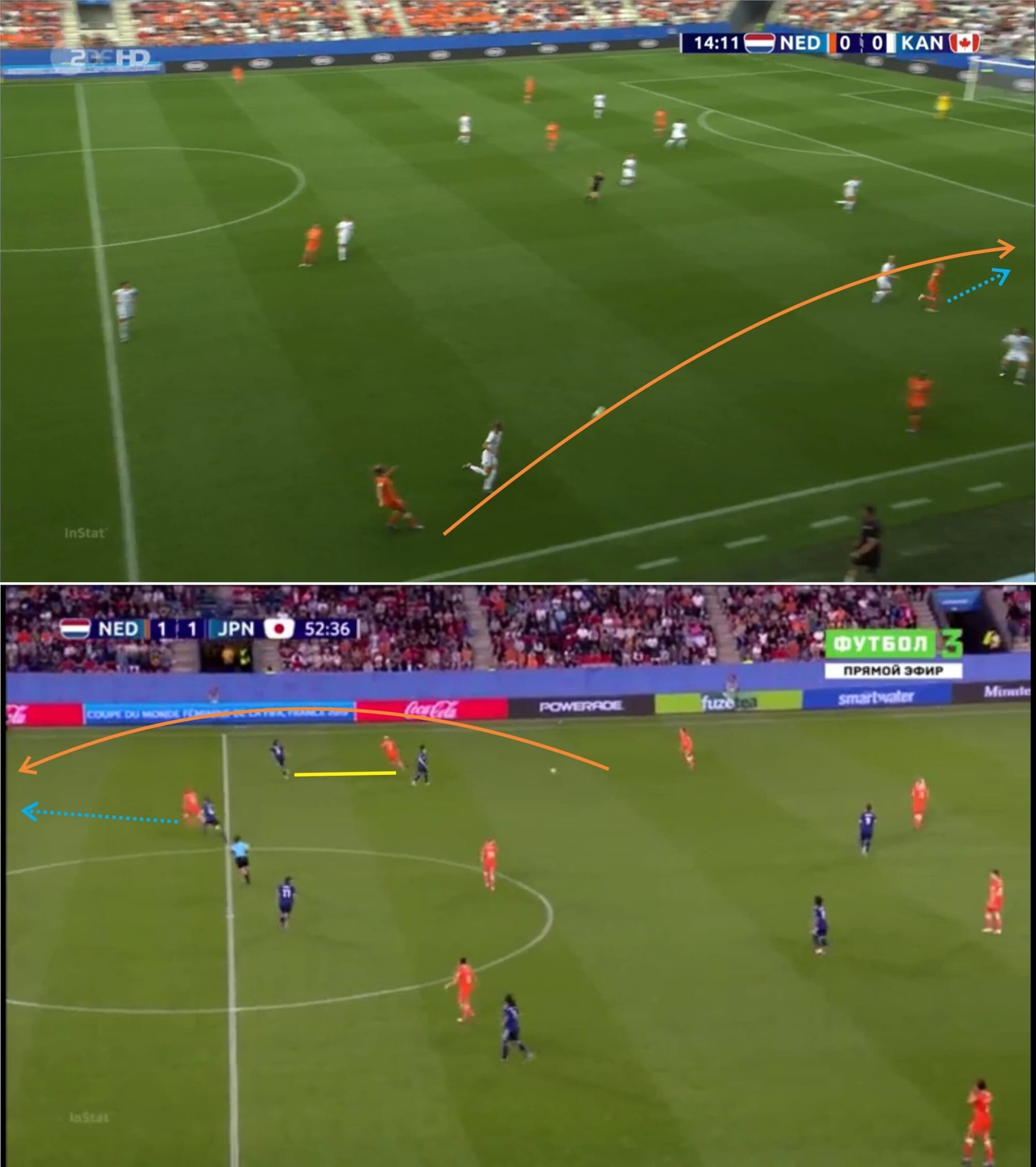
What happens in this attacking scenario is van de Sanden dropping deep, dragging the full-back with her. At the same time, Groenen starts her run from the half-space to exploit the spaces left by the opposing full-back. Van Lunteren can either play a one-two pass with van de Sanden first or deliver it directly onto the path of Groenen.
Strangely enough, this scenario didn’t happen a lot in the game against Sweden. Unlike van de Sanden who often dropped deep to link up with the full-back, Beerensteyn preferred staying high and wide, rendering the Dutch unable to complete their attacking routine.
Not so quick in breakaways
The Netherlands started the game with attacking intent, moving the ball around quickly with an emphasis on getting it forward. They seemed to try to score a goal early in the game so they could just sit back and defend the lead.
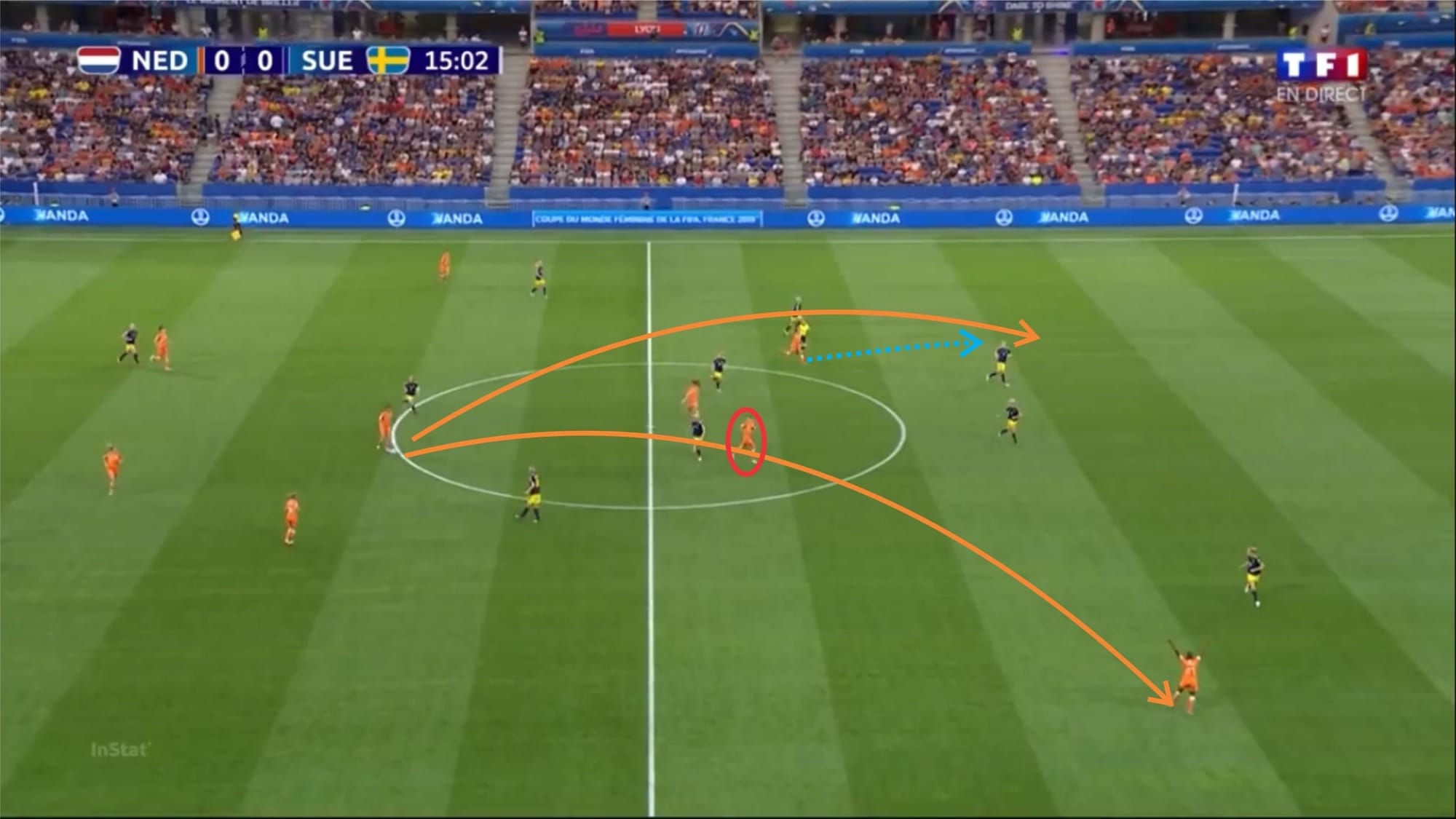
As usual, the Netherlands always tried to break quickly after regaining possession. The wingers quickly get into their strides and open up spaces. While one winger opened up space by stretching out wide, another one would try to make an inward run, exploiting the space between the defenders.
Miedema, as we can see once again, tended to stall her run rather than immediately bursting forward. This was because she’s often not the main target in counter-attacks, but the wingers were. Miedema would often arrive a bit later in the box to meet a cross from either winger who’s likely to be already inside the box or on the byline with the ball.
Unfortunately, they seemed to be unable to keep their attacking pace up in the second half. Very often, the Netherlands managed to regain possession and launch a counter but ended up missing the chance as they were too slow to make the crucial attacking decisions. Of, course, credits should also be given to the Swedish players for tracking back and transitioning quickly to defence after losing possession. However, the Netherlands were rather disappointing in this department.
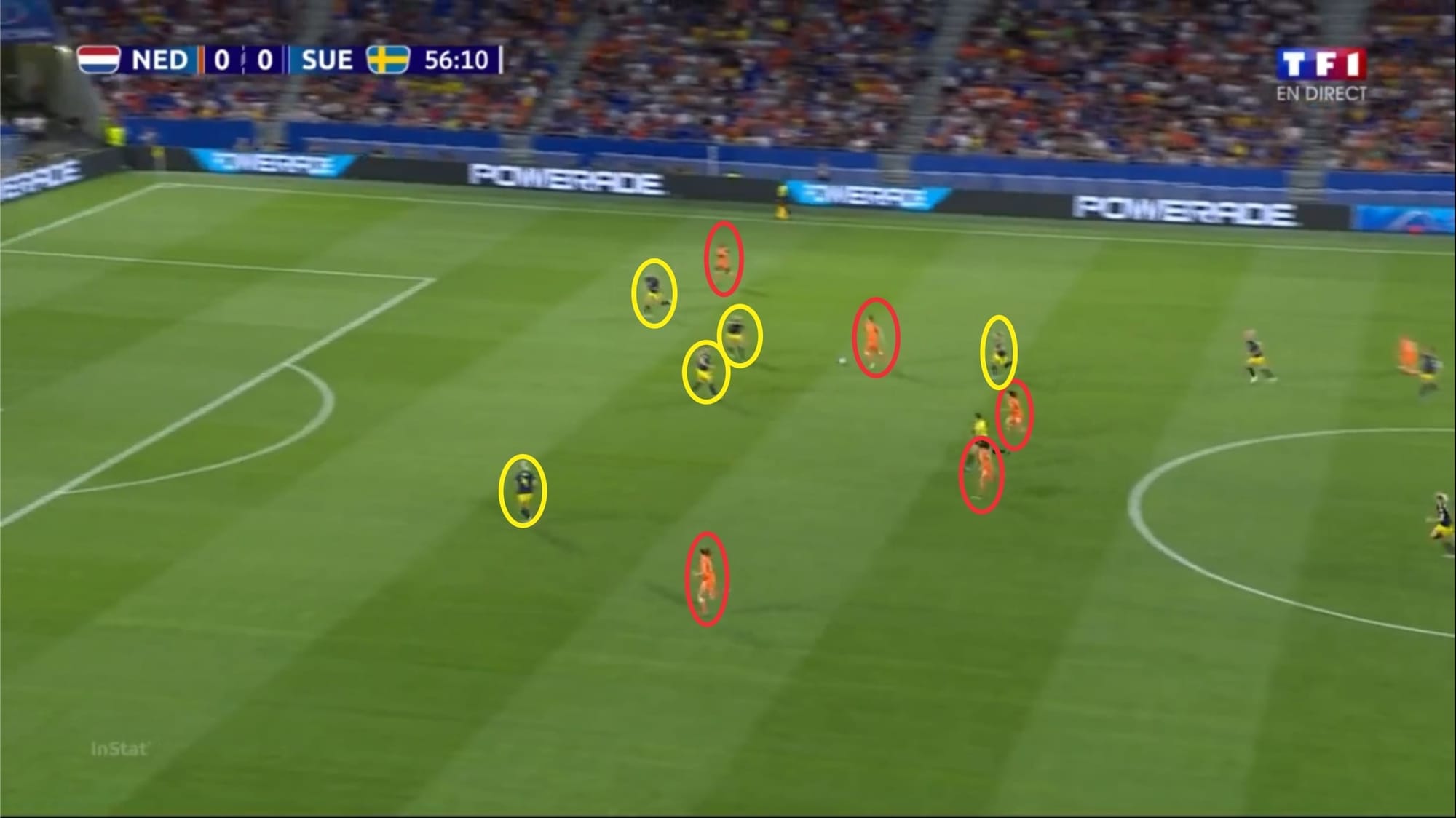
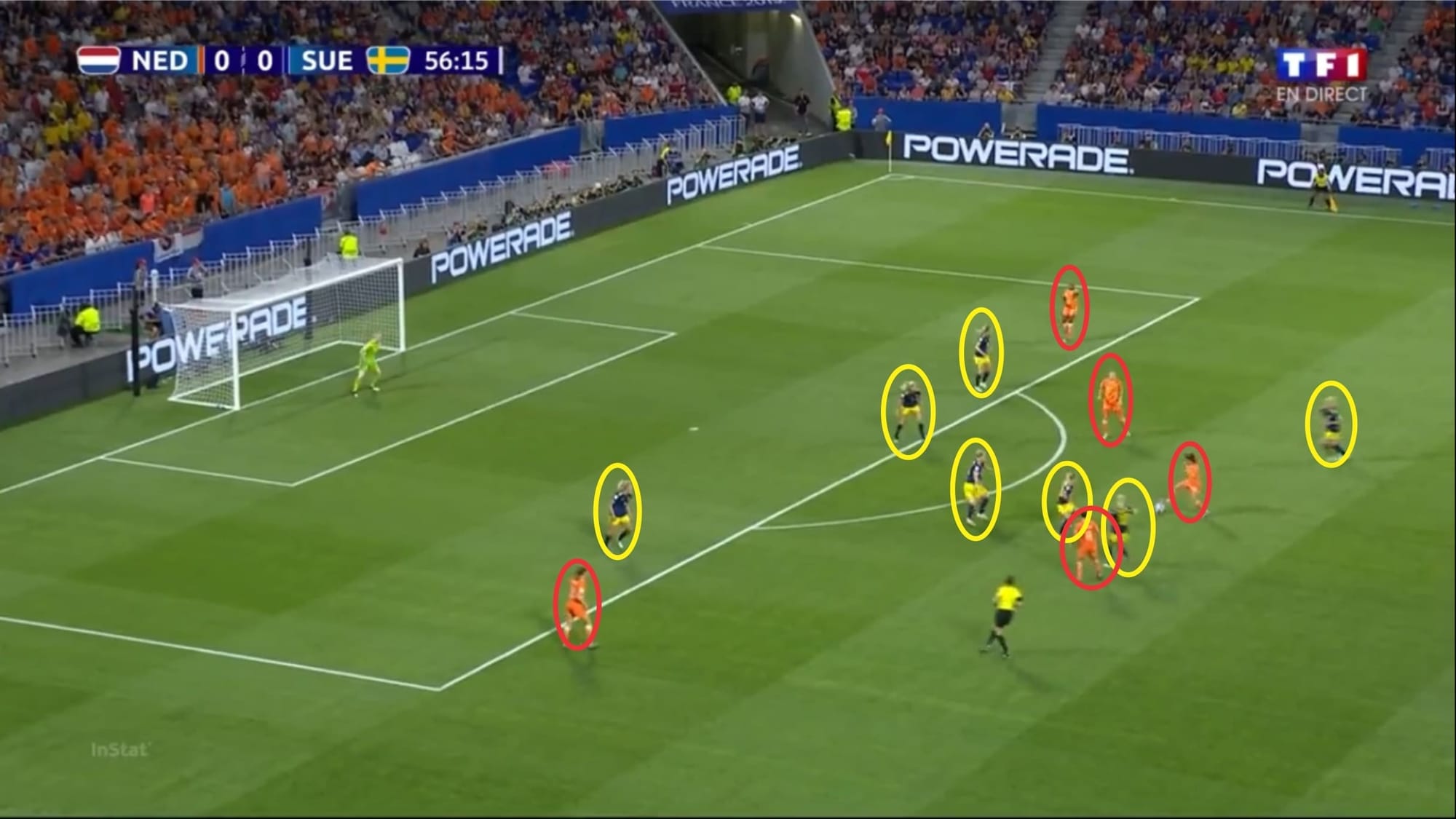
The first picture shows the Netherlands launching a counter-attack. In this situation, they were already superior in numbers with five players against four (one Swedish player was trailing). As we can see, Sweden still tried to slow them down and swarm the ball-carrier with the trailing player still playing her part in adding the pressure to the ball-carrier.
Meanwhile, the second picture shows that despite already on the front foot, the Netherlands were too slow to make the decisive attacking action. Sweden, on the other hand, were quick to track back and get back to defend. In this picture, we can see Sweden turning a five vs four situations into five vs seven. While Sweden immediately threw three additional players to help the defence, the Dutch players didn’t seem to receive any attacking support from their teammates.
Dull second half
Despite exchanging attacks throughout non-stop throughout the game, the show actually got rather dull in the second half. It’s not that the players played badly or anything. But all these beautiful plays and quick breakaways often ended in a disappointment.
The goalkeepers were, of course, absolutely brilliant, but the attackers desperately need to up their game.
Sweden’s attacks seemed to be turning into a rather repetitive, easily read pattern. While for the Netherlands, they might be dominating in possession and endlessly launching attacks into the defence of Sweden, but the decisive pass and the conversion were just not there.
The Netherlands seemed to get a lot of chances in the flanks with van de Donk and van de Sanden given more freedom on the flanks later in the second half. But the former seemed to be a bit too tired to even be able to control the ball properly under pressure, let alone deliver a proper cross into the box. The latter, on the other hand, was fresh as she was brought into the game in the second half, but her crosses were strangely abysmal – a lot of them were too strong, some were just simply inaccurate, poor crosses.
The Netherlands seemed a bit frustrated as they were clearly struggling to break Sweden’s defence and get the ball into the box. Much later in the game, they chose to take a shoot-on-sight approach. Spitse and Groenen were the main actors in this department, mainly due to their excellent shooting power and accuracy.
Both midfielders narrowly missed several of their attempts, but right in the 100th minute of the game, in the first half of extra time, Groenen found herself in an abundance of space just around the edge of the box. She took a shot which found the bottom right corner of the goalkeeper. Lindahl wasn’t able to reach the ball and tip it away from danger and it went in – much to the delight of all the players and staffs of the Netherlands as well as their fans inside the stadium.
This pretty much just goes to show that in a game that is just very balanced – each team have set up certain tactics against the other – improvisation may also come in handy. Wiegman has a team of skilled players who are able to play as a team but will never shy to showcase their ability individually and improvise when needed. In the end, aside from tactics, creativity also plays a part.
Sweden’s attacking endeavours
Just like the Netherlands, Sweden also tried to break quickly after regaining possession. The main differences were where they usually won the ball and who was their counter target.
The Netherlands usually won the ball in the midfield, slightly below the halfway line. A lot of other times, they’d win the ball in the opposition half.
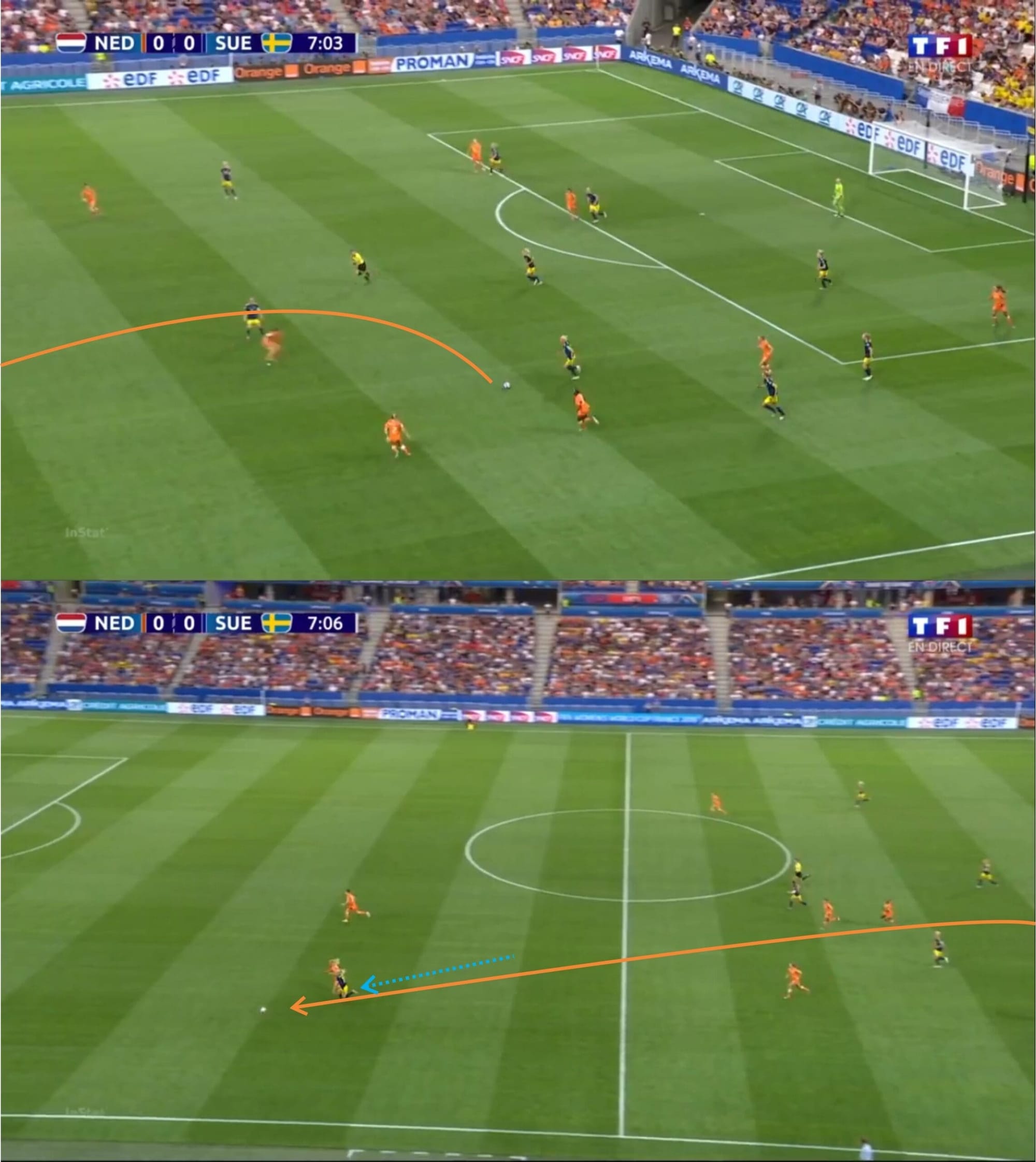
Sweden, on the other hand, won a lot of the balls deep in their own half. This was mostly because of their mid-low defensive block and less aggressive approach to pressing. Due to this, Sweden had to rely a lot on long, balls forward with striker Blackstenius being the main target in counter-attacks. The 22-year-old striker possesses an amazing amount of pace and is also very strong.
There were also two seemingly different approaches in attack by Sweden.
In positional attacks, Sweden usually tried to play through the middle. They tried to play from the back and progress through the middle. They seemed to try to deliver passes to players standing between the opposing midfield and defensive line, through the gap between the Dutch midfielders.
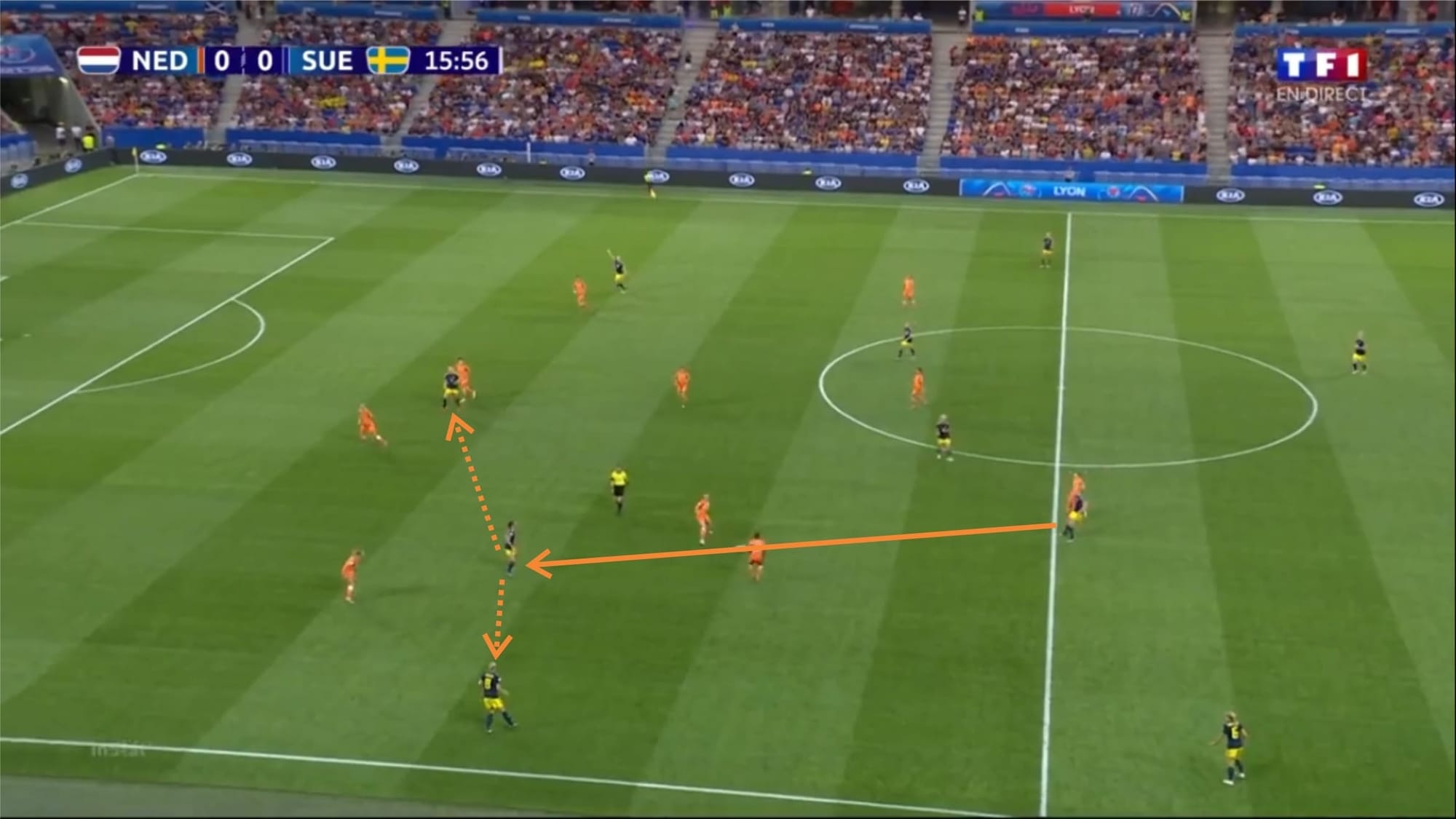
Despite mostly playing through the middle, Sweden tended to try to break through the flanks in positional attacks. With full-backs ready to maraud forward and wingers sitting narrower, Sweden were often successful in finding spaces to exploit out wide. Often, the wingers would also try to make an overlapping/underlapping run, receiving the ball in the byline, at the edge of the box. The Swedish wingers often wouldn’t try to cut inside with the ball, but rather hug the touchline and deliver crosses.
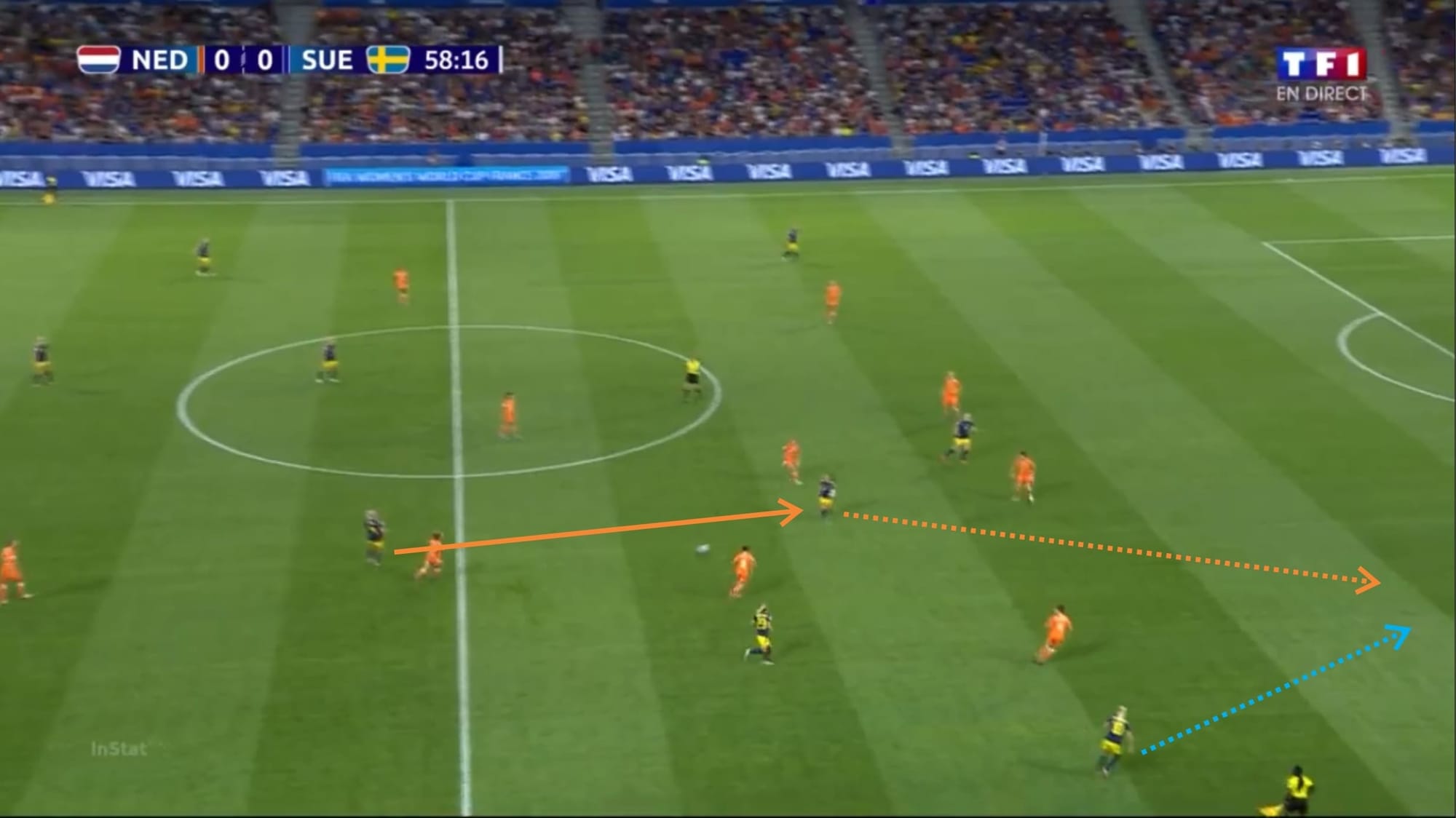
In counter-attacks, Sweden tended to break centrally as explained earlier. Blackstenius was the main target. She waited forward, getting ready to pounce on the ball delivered into spaces by her teammate as she played off the shoulder of the defenders. Her runs in behind the defence were extremely dangerous and De Oranje Leeuwinnen very nearly had to pay for it.
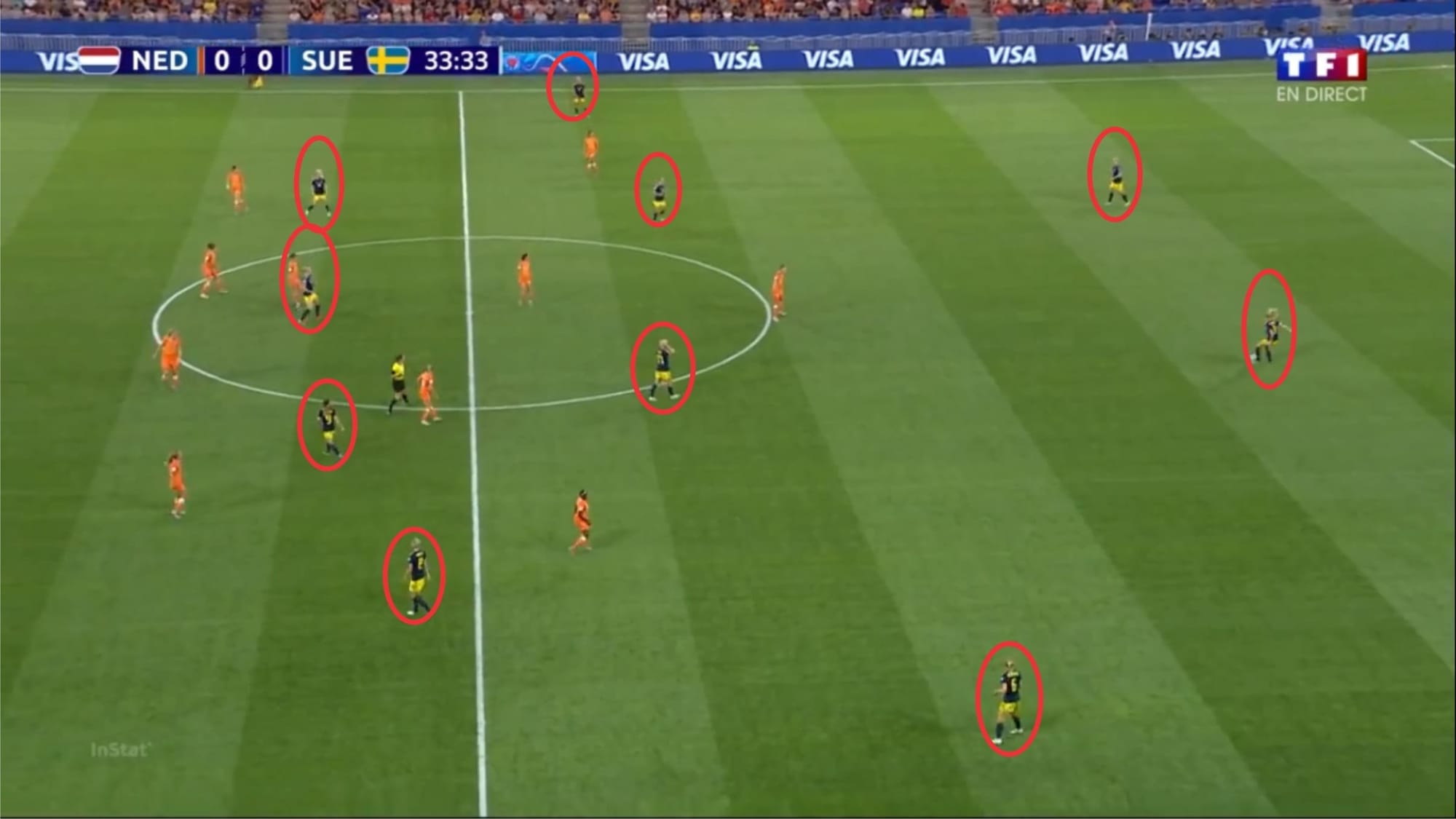
The picture above shows Sweden’s attacking shape. They seemed to morph into a 2-4-4 shape when in attack. Asllani positioned herself alongside Blackstenius, while both wingers sit narrower. The two full-backs sit rather high and wide to provide width. Sweden tended to play with medium-long passes, rather than exchanging short passes.
We can also see in the picture that the Netherlands defended with a compact medium block. Unlike Gerhardsson’s side, Wiegman’s team pressed high and aggressively. They seemed to try to win the ball back from as high up the pitch as possible.
Threatening each other through set-pieces
While the Netherlands have Spitse, Sweden have Ericsson. Both were outstanding set-piece takers, able to deliver pinpoint passes into the box or have a direct go at goal. Both the Netherlands and Sweden have their own tactics that they used in set-pieces though.
The Netherlands have so far scored five of their goals from set-pieces out of their total 11 goals. Four of them were from free-kicks and only one was from a corner kick.
With towering players and excellent headers such as Miedema, van der Gragt, Bloodworth, and Dekker always waiting inside the box in indirect free-kick situations, the Netherlands have a big advantage as well as big chance to score a goal. To add to that, they also have Spitse, who’s able to deliver highly-accurate balls into the box.
Their favourite position is an indirect free-kick in the left flank in the area between the box and the halfway line. It’s like delivering a cross from deep, but Spitse didn’t have to deal with the opposing team’s pressure. The attackers also all know where to position themselves. It’s telepathic.
Sweden, on the flip side, don’t really have such impressive statistics when it comes to set-pieces. They’ve only scored one goal from a set-piece situation out of their total 10 goals. But they sure proved that they could also be dangerous in these situations in their match against the Netherlands.
Gerhardsson’s side played smartly in set-pieces. In corner kicks especially. Sweden tended to overcrowd the six-yard box which could potentially result in a scrimmage in front of goal. The corner kick taker, which was either Asllani or Ericsson delivered the ball right into the crowded six-yard box. Sweden, of course, were not hoping to win the first ball, but they were ready to pounce on the second ball. Were it not for their being unlucky (hitting the post and denied by van Veenendaal), the results could have been completely different than what we see today.
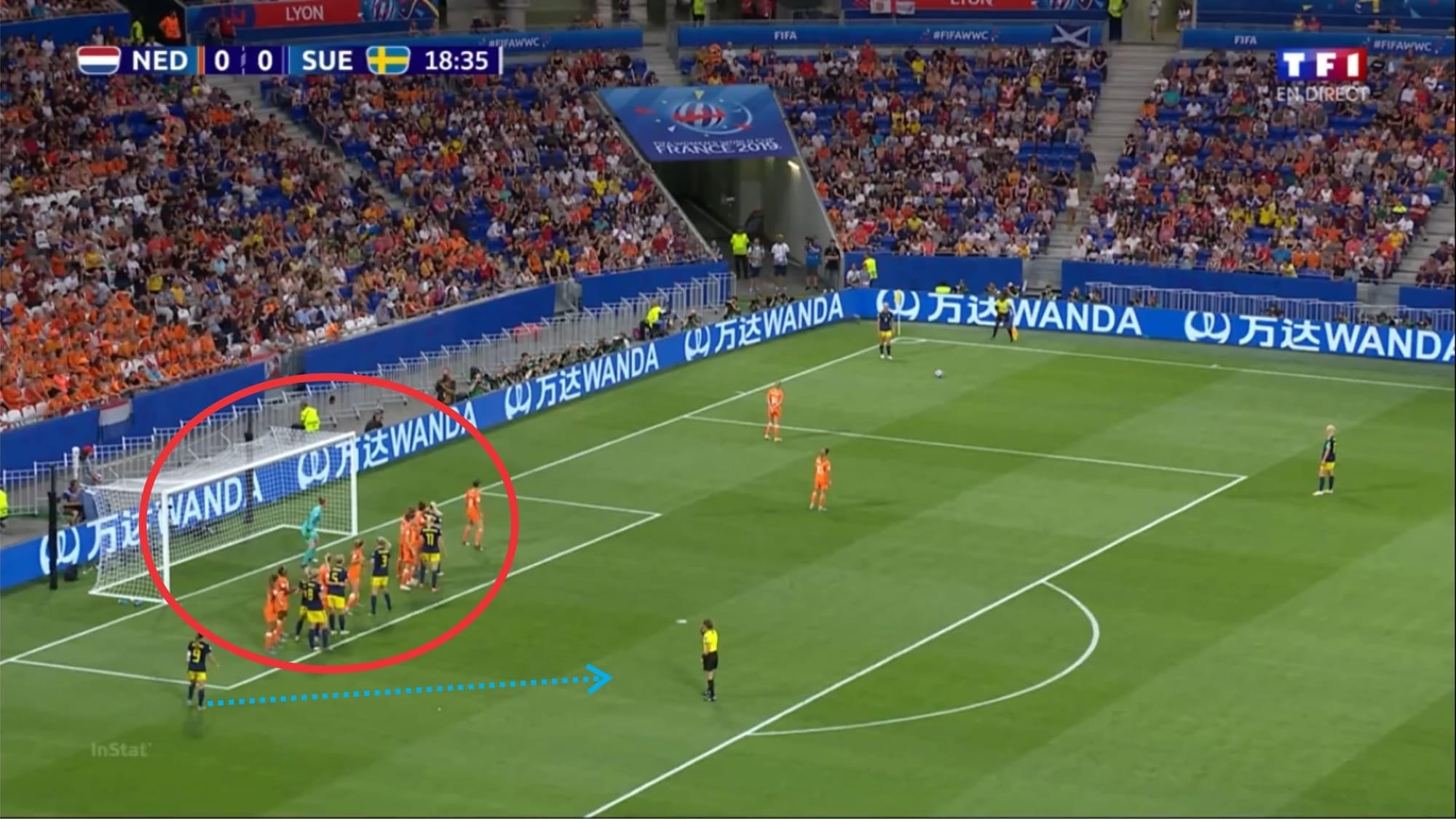
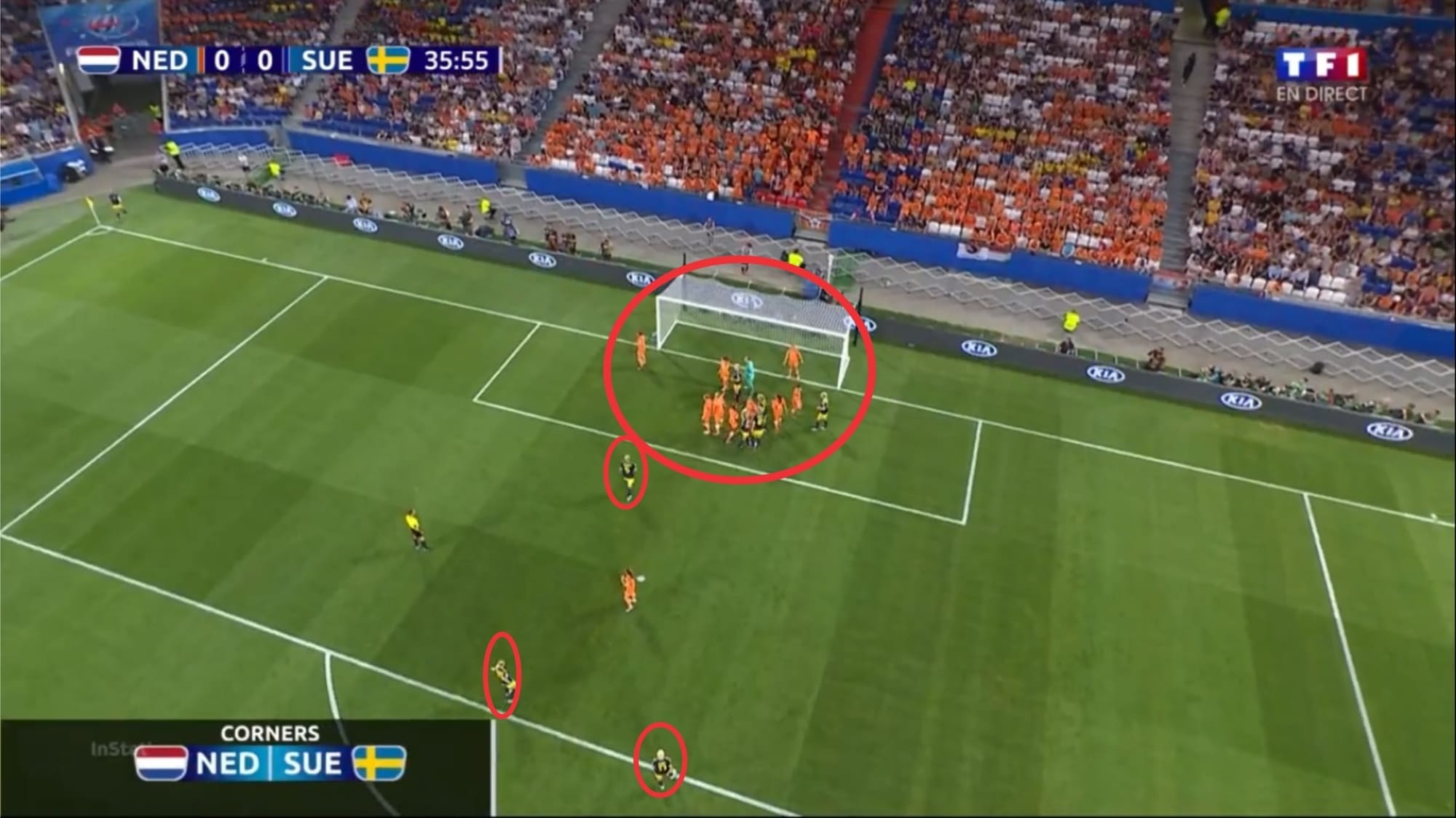
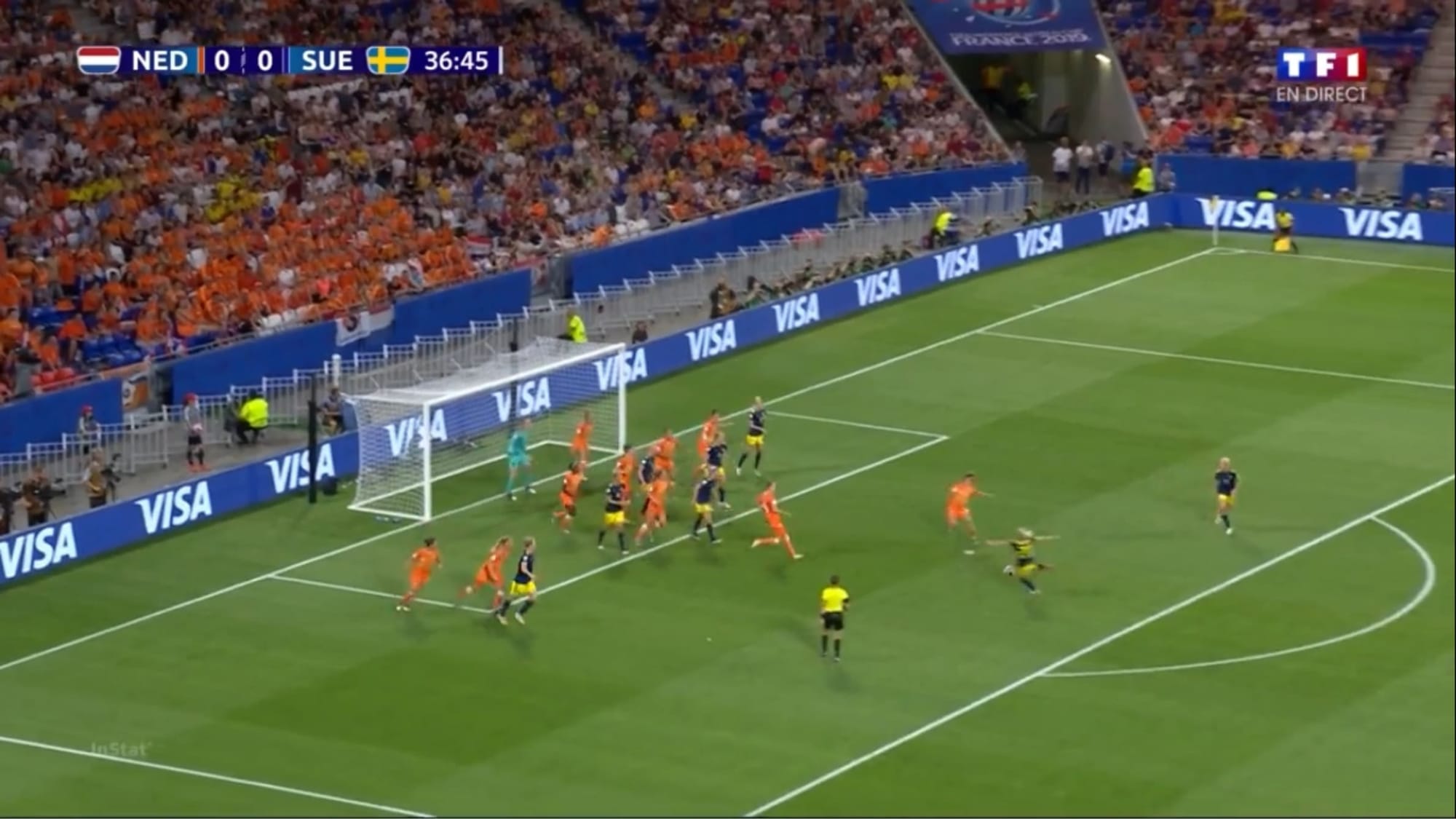
Relevant statistics
The Netherlands led in terms of possession throughout the game. They recorded around 54%–58% possession throughout the game while Sweden struggled to keep the ball – managing to keep around 42%–46% throughout the game.
The Netherlands also led in total passes with 674 total passes and they managed to complete 78% of them. Sweden, meanwhile, completed only 72% of their total 505 passes.
This match also saw both teams conceding a lot of fouls which disrupted the game a little bit, killing a team’s momentum sometimes. The Netherlands conceded around 13 fouls in the game, while Sweden conceded 24.
Wiegman’s side had an xG value of 1.76 from a total of 16 shots with six of them being on target. Gerhardsson’s side, on the opposite side, recorded a total of 12 shots with five of them being on target, resulting in an xG value of 1.28.
A huge number of Netherlands’ attacks came from the right side (58) which is understandable as I’ve explained before in this tactical analysis. Only 27 and 24 attacks come from the left side and the centre respectively for the Netherlands. Sweden, on the other hand, were a bit more balanced. 43 of their attacks came from the left, while 45 came from the right. Only 27 attacks came from the centre.
In this game, the Dutch also allowed only 3.2 passes per defensive action. This really showed how intense and aggressive they were in their pressing game. As I’ve also mentioned before, Sweden seemed to be less aggressive in pressing. This is proven with their allowing 6.1 passes per defensive action in this match.
Conclusion
Both teams battled with their hearts out in this game. But in the end, the Netherlands ran out victorious – and they deservedly so.
A battle of two different tactics, an intricate duel. Tactics might have affected the way the game was played a lot, but the players’ spirit, the passion might be the key to determine who’d come out on top.
Both teams performed very well in this very balanced game. Regardless of the result, the players, the coaches, and the fans should be proud of how their team played yesterday.
For the Netherlands, they’ll continue making history as they pave their way into their first-ever FIFA Women’s World Cup final. However, they’ll be facing the terrifying figure of the USA who defeated England in the semi-finals.
As for Sweden, they’ll have to fight against England for the third place on Saturday. There’s no doubt at all that this will still be an equally exciting match as the grand final.
If you love tactical analysis, then you’ll love the digital magazines from totalfootballanalysis.com – a guaranteed 100+ pages of pure tactical analysis covering topics from the Premier League, Serie A, La Liga, Bundesliga and many, many more. Buy your copy of the June issue for just ₤4.99 here, or even better sign up for a ₤50 annual membership (12 monthly issues plus the annual review) right here.

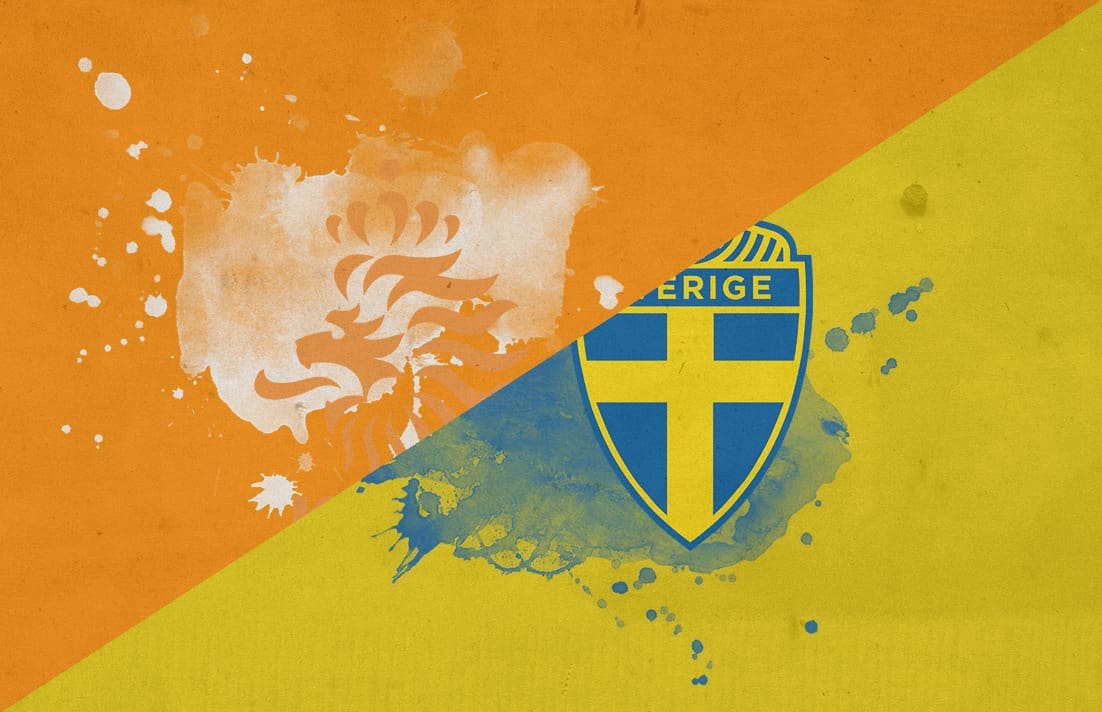



Comments